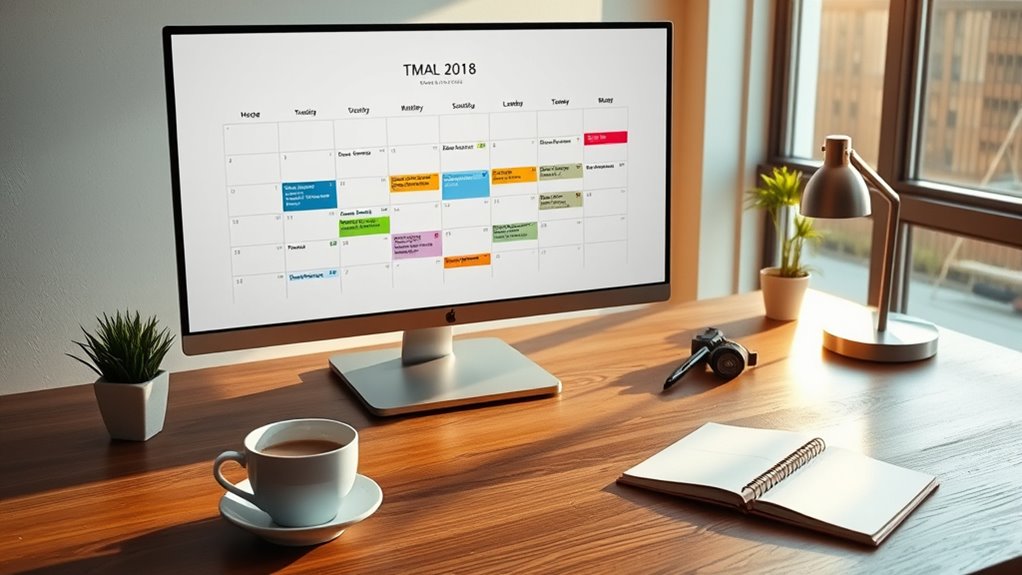Time blocking helps you schedule your day for maximum focus and flow by setting dedicated periods for specific tasks, especially high-priority ones. It minimizes distractions, reduces decision fatigue, and boosts productivity by creating routines and visual organization of your tasks. Incorporating buffer times allows flexibility for unexpected events, while focusing on peak energy periods enhances deep work. Stay tuned to discover how to implement these strategies effectively and transform your daily productivity.
Key Takeaways
- Divides the day into dedicated segments to prioritize high-impact tasks and create a predictable, controlled workflow.
- Uses structured routines and visual organization to reduce distractions and improve schedule adherence.
- Incorporates buffer periods for breaks and unforeseen events, allowing flexibility and maintaining focus.
- Enhances productivity by scheduling high-priority tasks during peak energy times and minimizing context switching.
- Promotes wellbeing through clear boundaries, regular breaks, and allocated time for self-care, reducing stress and mental fatigue.
Understanding the Core Principles of Time Blocking

What are the fundamental ideas behind time blocking? At its core, time blocking involves dividing your day into dedicated segments for specific tasks or groups of tasks. Instead of reacting to incoming work or relying solely on to-do lists, you proactively schedule when and how long each activity will take. This creates a predictable, controlled flow of time, helping you stay focused and avoid multitasking. It’s about fitting your workload like puzzle pieces into a strategic plan, ensuring high-priority tasks get enough attention. Time blocking encourages routine, discipline, and a clear structure, making your day more manageable. By intentionally allocating time for each activity, you reduce distractions, streamline your efforts, and foster a sense of control over your schedule. Incorporating techniques like vegetable juices can also boost your energy and focus throughout your planned schedule.
Unlocking Productivity Benefits Through Strategic Scheduling

Strategic scheduling through time blocking releases significant productivity benefits by ensuring you dedicate focused periods to high-priority tasks. When you assign specific time slots for important activities, you prevent distractions and reduce procrastination. This approach helps you concentrate deeply on what matters most, boosting the quality of your work. By batching similar tasks into designated blocks, you minimize context switching, saving mental energy and increasing efficiency. Additionally, clear schedules make it easier to track progress, stay organized, and meet deadlines. The structure provides a sense of control, reducing stress and overwhelm. Over time, strategic scheduling builds discipline and routine, turning time management into a powerful tool for maximizing output, maintaining focus, and achieving your goals with less wasted effort.
Enhancing Focus and Deep Work With Time Management Techniques

By minimizing distractions and creating focused work periods, you can considerably boost your ability to concentrate on important tasks. Scheduling dedicated blocks for deep work helps you stay on track and avoid interruptions. When you allocate specific times for focused effort, you make it easier to produce high-quality results without constant multitasking. Incorporating consistent routines, such as time blocking, can further enhance your productivity and help establish effective work habits.
Minimize Distractions Effectively
Reducing distractions is essential for maximizing your focus and opening deep work. To do this effectively, identify common interruptions and create strategies to block or eliminate them. Use quiet environments, turn off notifications, and set clear boundaries with colleagues or family. Prioritize tasks during your most alert periods to minimize the impact of external disruptions. Consider batching minor interruptions—like checking emails—for designated times. Additionally, understanding the different types of cookies and their purposes can help inform your online practices and privacy preferences cookie management.
Allocate Focused Work Periods
Allocating focused work periods is a key component of effective time management that builds upon minimizing distractions. When you set aside dedicated blocks for deep work, you maximize your mental energy and productivity. This approach helps prevent task-switching and encourages sustained concentration. To optimize these periods, consider:
- Scheduling high-priority tasks during your peak energy times for better focus.
- Limiting interruptions by signaling unavailability during these blocks.
- Breaking large projects into smaller, manageable chunks to maintain momentum.
- Incorporating short, intentional breaks to recharge without losing momentum.
- Selecting vetted tools and resources to ensure quality and reliability during your focused sessions.
Psychological Gains: Reducing Overload and Decision Fatigue

By planning your day with time blocks, you simplify daily choices and reduce mental clutter. This approach helps you stay focused on one task at a time, avoiding constant decision-making. As a result, you conserve mental energy and lower the risk of decision fatigue. Incorporating structured scheduling can also support healthier habits, such as juice cleansing, by allocating dedicated time for preparation and recovery.
Simplifies Daily Choices
Time blocking simplifies your daily decisions by providing a clear structure for your day, making it easier to choose what to focus on next. Instead of wasting mental energy on figuring out what to do, your schedule guides you seamlessly through tasks. This reduces overwhelm and decision fatigue, freeing your mind for more important work. Engaging in gear shifting during rides can serve as a mental break, helping to reset your focus and maintain momentum throughout the day. You know exactly when to work on each task, eliminating the need for constant planning. You avoid wasting time debating what to do next, staying focused and efficient. You’re less likely to get sidetracked by non-urgent distractions. Your brain can rest easy, trusting that your schedule supports your productivity, not hampers it.
With time blocking, decision-making becomes streamlined, so you spend less energy on planning and more on doing.
Decreases Mental Clutter
Time blocking helps clear mental clutter by providing a structured plan that makes your day predictable and manageable. When you know exactly what to work on and when, your mind relaxes from constant decision-making and uncertainty. This reduces overload by eliminating the need to juggle multiple tasks simultaneously or constantly switch contexts. Instead, you focus on one activity at a time within designated blocks, freeing mental resources for deeper concentration. The clear schedule minimizes the mental fatigue caused by unplanned interruptions or last-minute choices. As a result, you experience less stress and feel more in control. With fewer competing priorities vying for attention, your mind stays calmer, allowing you to approach tasks with greater clarity and confidence. Incorporating mindful planning techniques further enhances mental clarity by aligning your daily tasks with your overall goals.
Enhances Focused Attention
When you structure your day with time blocking, you create focused periods that minimize distractions and mental clutter. This intentional approach helps your brain stay engaged on one task at a time, boosting your concentration. By knowing exactly what to work on and when, you eliminate constant decision-making, reducing mental fatigue. Time blocking also helps set clear boundaries, so you’re less likely to multitask or switch tasks prematurely. Incorporating techniques like focused attention can further enhance your ability to maintain deep concentration during these dedicated intervals.
Practical Steps to Implement Effective Time Blocks

To implement effective time blocks, start by clearly identifying your most important tasks and estimating how much time they typically require. Break large projects into smaller, manageable segments, then assign each a specific time slot. Use a calendar or scheduling tool to create blocks dedicated to different tasks, prioritizing high-impact work first. Be realistic about how long each activity takes; track your time initially to improve accuracy. Combine similar tasks to minimize context switching and boost efficiency. Include buffer periods for breaks and unexpected interruptions. Adjust your schedule as needed based on your experience and workload. Stay disciplined by sticking to your planned blocks, but remain flexible enough to reschedule when priorities shift or unforeseen events arise. Incorporating visual organization methods can further enhance your ability to follow your schedule effectively.
Balancing Work and Wellbeing With Structured Scheduling

Balancing work and wellbeing is essential for sustained productivity and overall health, and structured scheduling plays a crucial role in achieving this harmony. When you plan your day with clear time blocks, you create space for both work and self-care. This approach helps prevent burnout by incorporating regular breaks and boundaries, making it easier to switch off after work. By intentionally scheduling downtime, exercise, or relaxation, you reduce stress and improve mental clarity.
- Allocate specific “me-time” or activity blocks to prioritize your health
- Schedule regular breaks to recharge and avoid fatigue
- Set boundaries to prevent work from spilling into personal time
- Use buffers to handle unexpected delays without disrupting wellbeing
Adapting Time Blocking to Dynamic and Unpredictable Days

Even with well-structured time blocks, unexpected events can disrupt your carefully planned day. To stay flexible, build buffer periods into your schedule for urgent matters or delays. Prioritize tasks by their importance, and be ready to reschedule less critical activities when surprises arise. Use a digital calendar that allows quick adjustments, so you can move blocks without losing track of your overall plan. Adopt a mindset that views disruptions as opportunities to reassess and adapt rather than setbacks. Keep a short list of high-priority tasks to focus on if your day shifts unexpectedly. Regularly review and tweak your schedule throughout the day to maintain momentum. Flexibility is key to making time blocking work effectively amid unpredictability.
Overcoming Challenges and Building Discipline in Time Management

Building discipline in time management can be challenging, especially when initial motivation wanes or distractions increase. To stay on track, you need strategies that reinforce your commitment and make sticking to your schedule easier.
- Set clear goals and prioritize tasks to stay focused on what truly matters.
- Start small by blocking time for single tasks before expanding to full days.
- Use reminders and accountability partners to reinforce consistency.
- Review and adjust your schedule regularly to identify what works and refine your approach.
Frequently Asked Questions
How Do I Handle Unexpected Urgent Tasks During Scheduled Blocks?
When unexpected urgent tasks pop up, you should quickly assess their priority. If they’re critical, reschedule or adjust your current time block, perhaps by shortening or moving tasks. Communicate with colleagues if needed, and stay flexible. Remember, it’s normal to adapt. By staying calm and pragmatic, you can handle interruptions without losing focus on your overall goals, ensuring productivity while managing urgent issues efficiently.
Can Time Blocking Work Effectively for Collaborative or Spontaneous Tasks?
Time blocking can work surprisingly well for collaborative or spontaneous tasks if you’re flexible and strategic. You should set aside buffer blocks for unexpected needs, allowing quick adjustments without throwing off your entire schedule. Communicate your schedule clearly with teammates, so they know when you’re available. By blending focused blocks with open periods, you create a dynamic system that adapts to spontaneity while maintaining overall productivity.
What Tools or Apps Are Best for Implementing Time Blocking?
You should try tools like Google Calendar or Outlook, which let you easily create, adjust, and visualize your time blocks. Apps like Todoist or Trello integrate well for task management, helping you assign specific tasks to your schedule. For more automation, try dedicated time blocking apps like Clockwise or Focus Booster. These tools help you stay organized, adapt your schedule quickly, and maintain focus throughout your day.
How Do I Estimate Task Durations Accurately Over Time?
To estimate task durations accurately, start by tracking how long each task takes over several attempts. Pay attention to patterns and adjust your estimates based on past experiences. Break down larger tasks into smaller steps to refine timing. Be realistic about distractions and breaks, and don’t forget to include buffer time. Over time, your estimates will become more precise as you learn what’s feasible within each time block.
Is Time Blocking Suitable for Highly Flexible or Unpredictable Work Environments?
Absolutely, time blocking can be a game-changer even in unpredictable work environments. It’s like building a flexible skeleton that adapts to surprises, giving you structure amid chaos. You can set broad timeframes for tasks, then adjust on the fly without losing control. This way, you stay focused and productive, turning what seems like chaos into a well-orchestrated symphony of work, even when everything changes suddenly.
Conclusion
By embracing time blocking, you gently steer your day toward clarity and calm, making space for focus and flow. It’s a soft dance between structure and flexibility, helping you avoid the overwhelm of endless choices. With patience and practice, you’ll find your rhythm, balancing productivity with well-being. Remember, every small step forward brings you closer to a more intentional, fulfilling day—trust the process and let your schedule guide you gracefully.









